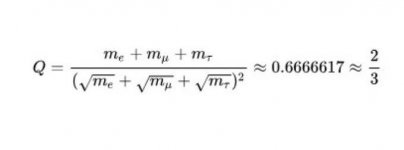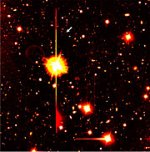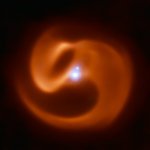If the article Gulu linked to is correct, we nor our grandchildren won't see that happen in their lifetimes..Galu, the big question is, when will it go pop!
besides... I'm way to impatient to wait for 100K years..
That's fascinating. I assumed methods to determine distances to other (nearby) stars would be more accurate than that. It now occurs to me that I have no idea how they determine distances to such stars. Anyone know?The new estimate of Betelgeuse's physical size has led to a new determination of its distance from Earth. It's a mere 530 light years away - 25% closer than previously thought.
I recall that the nearest star (other than the Sun, of course) is four light years away, and indeed Wikipedia gives the distance to four significant figures (!):
Proxima Centauri - Wikipedia
I somewhat recall that such nearby stars' distances are determined by parallax from the Earth being in different places at different times of the year due to its orbit around the Sun, and the appearance of the stars in reference to the background stars behind them. I don't know for how far away that would be useful.
If the article Gulu linked to is correct, we nor our grandchildren won't see that happen in their lifetimes..
besides... I'm way to impatient to wait for 100K years..
Regrettably I think you’re right.
I just looked up Betelgeuse (or Betelgeux) in Patrick Moore's Observers book of astronomy. It's the red star top left, with blue Rigel (0.08 magnitude) bottom right.
He's dead on the money. In 1962 he lists Betelgeuse as 520 light years away and the size of Earth's orbit.
He lists it as having a 5 year period 0.1 to 1.3 magnitude. It's actually dropped to 1.8 recently, putting it on a par with the three stars in the belt.
He's dead on the money. In 1962 he lists Betelgeuse as 520 light years away and the size of Earth's orbit.
He lists it as having a 5 year period 0.1 to 1.3 magnitude. It's actually dropped to 1.8 recently, putting it on a par with the three stars in the belt.
To be fair, they do give quite a large range for the diameter, but Patrick Moore was in a class of his own
Betelgeuse - Wikipedia
This afaik is now considered the largest known star
Stephenson 2-18 - Wikipedia
And here is the heaviest known at c. 215 Ms
R136a1 - Wikipedia
There’s some monsters out there!
Betelgeuse - Wikipedia
This afaik is now considered the largest known star
Stephenson 2-18 - Wikipedia
And here is the heaviest known at c. 215 Ms
R136a1 - Wikipedia
There’s some monsters out there!
You mentioned Parallax, but there's at least two more methods:It now occurs to me that I have no idea how they determine distances to such stars. Anyone know?
- Parallax Stellar Distances - The astronomical use of parallax
- Cepheid Variables Variable Stars - Cepheids as Distance Markers
- Colour Stellar distances - Colour
A fascinating diversion into SuperNovas. 
Apparently we get them about 3 times a century in our Galaxy. I remember SN-1987A in the nearby Magellan Clouds. Reached magnitude 3. We felt its presence. The neutrino burst woke up the House one night. We all had a terrible nights sleep. We happened to have a resident Physicist upstairs who explained it. Sort of bright flash in your head! Weirdness. Like a goose stepping on your grave, you ever had that strange feeling?
SN 1987A - Wikipedia
There was a whopper in 1604. Reached -2.5 for three weeks, about the same as Jupiter.
Kepler's Supernova - Wikipedia
Far more common are Novas. We get 30-60 a year, but they don't get very bright.
Apparently a SuperNova is very bad news within 30 light years. Strips away the Ozone layer:
This supernova blast was so close, it littered the ocean floor with radioactive dust | PBS NewsHour
Apparently we get them about 3 times a century in our Galaxy. I remember SN-1987A in the nearby Magellan Clouds. Reached magnitude 3. We felt its presence. The neutrino burst woke up the House one night. We all had a terrible nights sleep. We happened to have a resident Physicist upstairs who explained it. Sort of bright flash in your head! Weirdness. Like a goose stepping on your grave, you ever had that strange feeling?
SN 1987A - Wikipedia
There was a whopper in 1604. Reached -2.5 for three weeks, about the same as Jupiter.
Kepler's Supernova - Wikipedia
Far more common are Novas. We get 30-60 a year, but they don't get very bright.
Apparently a SuperNova is very bad news within 30 light years. Strips away the Ozone layer:
This supernova blast was so close, it littered the ocean floor with radioactive dust | PBS NewsHour
Last edited:
This story invokes the same degree of weirdness as the last time you mentioned it, Steve!We felt its presence. The neutrino burst woke up the House one night. Sort of bright flash in your head! Weirdness.
Impossibleness may be more descriptive, since neutrinos pass though normal matter unimpeded.
Then again, your grey matter is universally recognised as superseding the normal!
Last edited:
Neutrinos are one of the weirder particles in our Universe.
Neutrino - Wikipedia
They DO interract with matter, but only very lightly:
Neutrino detector - Wikipedia
Origionally conceived as a book-keeping device to balance momentum in certain Nuclear Decays, they have turned out to be very strange things indeed.
Koide formula - Wikipedia
They spend strange lives flipping between Electron, Muon and Tau flavours. TBH, I might have dreamt the whole thing in February 1987. Cold nights make you dream. And Simon Jones, who worked in the Patent Office like a certain other bright Physicist might have got it wrong. Maybe it was a Gamma Ray burst.
Neutrino - Wikipedia
They DO interract with matter, but only very lightly:
Neutrino detector - Wikipedia
Origionally conceived as a book-keeping device to balance momentum in certain Nuclear Decays, they have turned out to be very strange things indeed.
Koide formula - Wikipedia
They spend strange lives flipping between Electron, Muon and Tau flavours. TBH, I might have dreamt the whole thing in February 1987. Cold nights make you dream. And Simon Jones, who worked in the Patent Office like a certain other bright Physicist might have got it wrong. Maybe it was a Gamma Ray burst.
Low levels of gamma radiation encountered in the space environment can have an effect on human cognitive function!Maybe it was a Gamma Ray burst.
Ah, the Smoking Gun! I didn't make it up! 
Neutrino detector - Wikipedia
The field of neutrino astronomy is still very much in its infancy – the only confirmed extraterrestrial sources so far as of 2018 are the Sun and the supernova 1987A in the nearby Large Magellanic Cloud.
Neutrino detector - Wikipedia
The thing I fear is a GRB.
Anything within a 100k LY and we’re toast. Luckily the only ones we’ve detected are billions of LY away - nothing in our galaxy.
In a few seconds they release the same amount of energy as the sun does over the entire course of its 10 billion yr life.
Gamma-ray burst - Wikipedia
Anything within a 100k LY and we’re toast. Luckily the only ones we’ve detected are billions of LY away - nothing in our galaxy.
In a few seconds they release the same amount of energy as the sun does over the entire course of its 10 billion yr life.
Gamma-ray burst - Wikipedia
Last edited:
It wasn't the neutrino burst that was in doubt, it was the flash of light in your head!Ah, the Smoking Gun! I didn't make it up!

Keep those flashes of inspiration coming, Steve.
The thing I fear is a GRB.
NASA's Swift telescope detected it's 1,000th GRB in 2015. NASA's Swift Spots its Thousandth Gamma-ray Burst | NASAGamma Ray Bursts are believed to occur in a massive star whose core has run out of fuel and collapsed into a black hole. As matter falls toward the newly formed black hole, it launches jets of subatomic particles that move out through the star's outer layers at nearly the speed of light. When the particle jets reach the stellar surface, they emit gamma rays, the most energetic form of light.
The most remote gamma ray burst was observed in 2000. It was emitted when the Universe was very young, less than about 1,500 million years old, or only 10% of its present age.
The brightness was enormous, at least 1,000,000,000,000 times that of our Sun, or thousands of times that of the explosion of a Supernova.
Attachments
So far, no GRB has been detected within our Milky Way galaxy.
The most likely candidate to produce a GRB in our galaxy is one of the highly luminous stars that make up the binary Apep system which is located about 8000 light years from Earth.
Fortunately, Apep appears not to be aimed directly at Earth, because a gamma-ray burst at this proximity could strip ozone from our atmosphere, drastically increasing our exposure to UV light from the Sun.
The most likely candidate to produce a GRB in our galaxy is one of the highly luminous stars that make up the binary Apep system which is located about 8000 light years from Earth.
Fortunately, Apep appears not to be aimed directly at Earth, because a gamma-ray burst at this proximity could strip ozone from our atmosphere, drastically increasing our exposure to UV light from the Sun.
Attachments
- Status
- Not open for further replies.
- Home
- Member Areas
- The Lounge
- What is the Universe expanding into..


